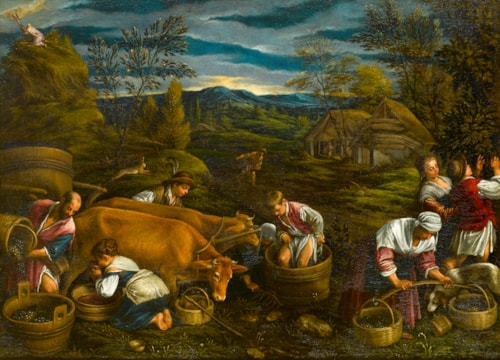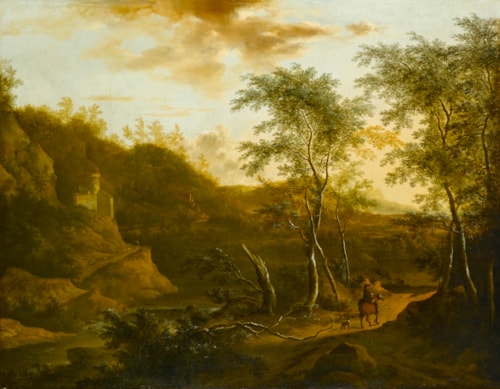ttributed to Pieter Jacobs Codde,
(Amsterdam 1599 - Amsterdam 1678)
Portrait of a Young Man as Bacchus
oil on panel
23.2 x 18.1 cm (9⅛ x 7⅛ in)
In this small panel painting Pieter Codde has depicted a young man in the guise of the Roman god of wine, Bacchus. Unlike a conventional portrait of the period, the sitter does not look towards the viewer, but stares out beyond the picture plane, creating a sense of detachment. This lack of engagement, along with his glazed expression, gives the sitter the slight air of inebriation appropriate for one dressed as Bacchus.
The present work is an example of a portrait historié, a genre that became increasingly popular in Dutch art from around 1630. Artists such as Codde would sometimes depict their sitters in the guise of mythological, biblical or historical figures, chosen to reflect an aspect of the subject’s personality. The young man in our work wears a wreath of vine leaves, an attribute of Bacchus, and so he is associated with the light-hearted and youthful nature for which the god was known.
The present work has many of the characteristics of Codde’s portraiture, despite the fact that using the specific genre of portrait historié was unusual for him. In his portraiture Codde often painted on small oak panels, of a similar size to our painting.¹ Another hallmark is the tonal unity that he brought to his work. Codde’s early portraits are painted in cool silver tones, and exemplified in the Mauritshuis’ Portrait of a Married Couple. Our portrait was painted slightly later, c. 1645, but here Codde also works in the same grey tones, but has begun to incorporate golds and browns into his palette, presumably under the influence of Rembrandt, who was also working in Amsterdam during this period. Between 1640-1650, Codde favoured the facial type seen in Portrait of a Young Man as Bacchus. A comparison between the present work and the Kremer Collection’s The Sacrifice of Polyxena, demonstrates how Codde’s figures have similar jowly features.
Codde was born in Amsterdam, where he spent most of his career. Although he was once thought to have been apprenticed to Frans Hals, in fact nothing concrete about his training is known, and his earliest dated work is from 1625. However, in 1637 he was commissioned to complete a large group portrait of Amsterdam’s civic guards, which Hals had left unfinished.² He is today best known for his guardroom scenes, but he was also a prolific portrait and history painter.
Dr. Fred Meijer attributed this work to Pieter Codde in 2003.
¹ For example a pair of portraits in the Museé des Beaux-Arts de Strasbourg (inv. nos. 568 & 569), measure 25x19 cm.
² Frans Hals & Pieter Codde, The Meagre Company, 1637, Rijskmuseum, Amsterdam (inv. no. SK-C-374).
Christie’s, London, 26 September 2003, lot 51 (as Circle of Salomon de Bray);
Lempertz, Cologne, 19 May 2007, lot 1022 (as Jan de Bray).
In this small panel painting Pieter Codde has depicted a young man in the guise of the Roman god of wine, Bacchus. Unlike a conventional portrait of the period, the sitter does not look towards the viewer, but stares out beyond the picture plane, creating a sense of detachment. This lack of engagement, along with his glazed expression, gives the sitter the slight air of inebriation appropriate for one dressed as Bacchus.
The present work is an example of a portrait historié, a genre that became increasingly popular in Dutch art from around 1630. Artists such as Codde would sometimes depict their sitters in the guise of mythological, biblical or historical figures, chosen to reflect an aspect of the subject’s personality. The young man in our work wears a wreath of vine leaves, an attribute of Bacchus, and so he is associated with the light-hearted and youthful nature for which the god was known.
The present work has many of the characteristics of Codde’s portraiture, despite the fact that using the specific genre of portrait historié was unusual for him. In his portraiture Codde often painted on small oak panels, of a similar size to our painting.¹ Another hallmark is the tonal unity that he brought to his work. Codde’s early portraits are painted in cool silver tones, and exemplified in the Mauritshuis’ Portrait of a Married Couple. Our portrait was painted slightly later, c. 1645, but here Codde also works in the same grey tones, but has begun to incorporate golds and browns into his palette, presumably under the influence of Rembrandt, who was also working in Amsterdam during this period. Between 1640-1650, Codde favoured the facial type seen in Portrait of a Young Man as Bacchus. A comparison between the present work and the Kremer Collection’s The Sacrifice of Polyxena, demonstrates how Codde’s figures have similar jowly features.
Codde was born in Amsterdam, where he spent most of his career. Although he was once thought to have been apprenticed to Frans Hals, in fact nothing concrete about his training is known, and his earliest dated work is from 1625. However, in 1637 he was commissioned to complete a large group portrait of Amsterdam’s civic guards, which Hals had left unfinished.² He is today best known for his guardroom scenes, but he was also a prolific portrait and history painter.
Dr. Fred Meijer attributed this work to Pieter Codde in 2003.
¹ For example a pair of portraits in the Museé des Beaux-Arts de Strasbourg (inv. nos. 568 & 569), measure 25x19 cm.
² Frans Hals & Pieter Codde, The Meagre Company, 1637, Rijskmuseum, Amsterdam (inv. no. SK-C-374).
Christie’s, London, 26 September 2003, lot 51 (as Circle of Salomon de Bray);
Lempertz, Cologne, 19 May 2007, lot 1022 (as Jan de Bray).





 contact
contact contact
contact +44 20 7313 8040
+44 20 7313 8040









